Research on Structural Design and Optimisation Analysis of a Downhole Multi-Parameter Real-Time Monitoring System for Intelligent Well Completion
Abstract
:1. Introduction
2. Materials and Properties
2.1. Multi-Parameter Real-Time Monitoring System Design Scheme
2.2. Mechanical Performance Analysis of Multi-Parameter Real-Time Monitoring Systems
3. Results and Discussion
3.1. Reliability Analysis of Monitoring Parameters Such as Water Content, Temperature, and Pressure
3.2. Reliability Analysis of Flow Monitoring with Reverse Venturi Flowmeters
3.2.1. Numerical Simulation Analysis for Flow Monitoring of Reverse Venturi Flowmeters
3.2.2. Comparison of Reverse Venturi Flowmeter Differential Pressure for Different Operating Conditions and Water Content
3.2.3. Comparison of Combined Flow Coefficients of Reverse Venturi Flowmeters for Different Operating Conditions and Water Contents
3.2.4. Analysis of Reverse Venturi Flow Monitoring Indoor Experimental Tests
3.2.5. Comparative Analysis of Pressure Difference between Simulation and Room Test under the Same Working Condition
3.2.6. Comparative Analysis of Integrated Flow Coefficients between Simulation and Indoor Testing under the Same Operating Conditions
4. Conclusions
- (1)
- The basic structure of the reverse-turi was designed, and the reverse-Venturi monitoring bin was analysed for mechanical and mechanical properties. The simulation results showed that the maximum stress was 841 MPa, the maximum radial displacement of the seal contact surface was 0.072 mm, and the strength and deformation met the design requirements.
- (2)
- An oil–water mixed fluid simulation was carried out. The simulation results show that the pressure drop curves of the inverted Venturi under four working conditions with different water contents tend to be consistent. The flow rate is proportional to the differential pressure; when the flow rate is certain, the higher the water content, the higher the differential pressure; when the water content is certain, the higher the flow rate, the higher the differential pressure, which is in line with the law of fluid flow in the Venturi.
- (3)
- Indoor experimental testing of reverse-Venturi fluid flow was carried out. It was analysed that the flow rate in the range of 500–1000 m3/d was measured with high accuracy, the error range was between ±5% and ±10%, and the maximum/minimum flow rate ratio of the flow measurement range in the experimental test was 2.5, which meets the design requirements. Simulation results and experimental test results are basically consistent; when the flow rate is 400–1000 m3/d, the error range is within 10%, and the structure is reliable.
- (4)
- An intelligent well-completion multi-parameter monitoring system can monitor the pressure, temperature, flow rate and other key parameters of oil and gas wells in real time to achieve real-time monitoring and control of the completion process. In this paper, by integrating multiple sensors in the mechanical structure design and through the prototype for experimental verification, it can monitor and collect the key parameters. Still, due to the complex mechanical structure and high processing difficulty, we will continue to improve the structure and carry out field experiments to verify its performance. With the increasing difficulty of global oil and gas field development, the intelligent well-completion multi-parameter monitoring system will play a more important role in future oil and gas field development.
Author Contributions
Funding
Data Availability Statement
Conflicts of Interest
References
- Li, G.; Song, X.; Zhu, Z.; Tian, S.; Sheng, M. Research progress and prospect of intelligent well completion technology. J. Oil Drill. Technol. 2023, 51, 35–47. [Google Scholar]
- Cayeux, E. Mathematical Modelling of the Drilling Process for Real-Time Applications in Drilling Simulation Interpretation and Assistance; University of Stavanger: Stavanger, Norway, 2019. [Google Scholar]
- Afuekwe, A.; Bello, K. Use of Smart Controls in Intelligent Well Completion to Optimize Oil & Gas Recovery. J. Eng. Res. Rep. 2019, 5, 1–14. [Google Scholar]
- Xu, X. Analysis of the Development Status and Prospects of Intelligent Well Completion Technology. Chem. Eng. Equip. 2020, 2, 89–90. [Google Scholar]
- Al-Kadem, M.; Gomaa, M.; Al Yateem, K.; Al Maghlouth, A. Multiphase Flow Meter Health Monitoring Strategy: Maximizing the Value of Real-Time Sensors and Automation for Industrial Revolution 4.0. In Proceedings of the SPE Annual Technical Conference and Exhibition, Dubai, United Arab Emirates, 21–23 September 2021. [Google Scholar]
- Malakooti, R.; Ayop, Z.A.; Maulianda, B.; Muradov, K.; Davies, D. Integrated production optimisation and monitoring of multi-zone intelligent wells. J. Pet. Explor. Prod. Technol. 2020, 10, 159–170. [Google Scholar] [CrossRef]
- Schaefer, C.D.B.; Sampaio, A.M. Efficient workflow for optimizing intelligent well completion using production parameters in real-time. Oil Gas Sci. Technol.-Rev. D’IFP Energ. Nouv. 2020, 75, 69. [Google Scholar] [CrossRef]
- Garcia, E.; Kevin, R. Advanced Reservoir Control Systems Paving the Way for Digital Offshore Operations and Analysis. In Proceedings of the SPE Canadian Energy Technology Conference, Calgary, AB, Canada, 16–17 March 2022. [Google Scholar]
- Jia, D.; Pei, X.; Zhu, Z.; Zhu, S.; Liu, C.; Guo, T. Study on the Application of Whole Process Monitoring and Control Technology for Separated Layer Water Injection to Block. In Proceedings of the SPE/IATMI Asia Pacific Oil & Gas Conference and Exhibition, Jakarta, Indonesia, 17–19 October 2017. [Google Scholar]
- Gonzalez, L.E.; Chokshi, R.N.; Lane, W. Importance of Downhole Measurements, Visualization and Analysis in Producing Unconventional Wells. In Proceedings of the SPE Unconventional Resources Technology Conference, San Antonio, TX, USA, 20–22 July 2015. [Google Scholar]
- Kamal, B.; Abbasi, Z.; Hassanzadeh, H. Water-Cut Measurement Techniques in Oil Production and Processing-A Review. Energies 2023, 16, 6410. [Google Scholar] [CrossRef]
- Meng, Z.; Huang, Z.; Wang, B.; Ji, H.; Li, H.; Yan, Y. Air–water two-phase flow measurement using a Venturi meter and an electrical resistance tomography sensor. Flow Meas. Instrum. 2010, 21, 268–276. [Google Scholar] [CrossRef]
- Perumal, K.; Krishnan, J. A CFD study of the effect of venturi geometry on high pressure wet gas metering. Int. J. Oil Gas Coal Technol. 2013, 6, 549–566. [Google Scholar] [CrossRef]
- Xue, C. Development and Performance Study of Integrated Underwater Venturi Two Phase Wet Gas Flowmeter; Beijing University of Chemical Technology: Beijing, China, 2018. [Google Scholar]
- Zhan, M.; Xie, C.G.; Shu, J.J. Microwave probe sensing location for Venturi-based real-time multiphase flowmeter. J. Pet. Sci. Eng. 2022, 218, 111027. [Google Scholar] [CrossRef]
- Saeed, A.; Noui-Mehidi, M.N.; Black, M.J.; Abbad, M.; Shafiq, M. A Full Scale Two-Phase Flow Loop Test of Downhole Permanent Multiphase Flow Meter. In Proceedings of the SPE Middle East Oil & Gas Show and Conference, Manama, Bahrain, 8–11 March 2015. [Google Scholar]
- Danilko, A.; Senkov, A.; Andreev, A. Virtual Flowmetering for Intelligent Wells. In Proceedings of the SPE Russian Petroleum Technology Conference, Moscow, Russia, 22–24 October 2019. [Google Scholar]
- Feng, G.; Yin, Y.; Ma, L.; Zhang, L.; Wang, W. Development and Application of Intelligent Well Technology in Offshore Oilfield. J. Southwest Pet. Univ. (Nat. Sci. Ed.) 2022, 44, 153–164. [Google Scholar]
- Shi, H.; Ruban, A.; Timoshchenko, S.; Nikrityuk, P. Numerical Investigation of the Behavior of an Oil-Water Mixture in a Venturi Tube. Energy Fuels 2020, 34, 15061–15067. [Google Scholar] [CrossRef]
- Golenkin, M.Y.E.; Bulygin, I.A.; Shapovalov, A.P.; Zavyalov, A.A.; Zhirkina, A.A.; Pico, Y.L.; Knyazev, I.V. Digital Production Optimization Boost for North Caspian Field with 3-Phase Real-Time Downhole Flow Metering System from Enhanced Intelligent Completion. In Proceedings of the SPE Russian Petroleum Technology Conference, Virtual, 26–29 October 2020. [Google Scholar]
- Meribout, M.; Azzi, A.; Ghendour, N.; Kharoua, N.; Khezzar, L.; AlHosani, E. Multiphase Flow Meters Targeting Oil Gas Industries. Measurement 2020, 165, 108111. [Google Scholar] [CrossRef]
- Deng, R.; Hu, K.; Liang, D.; Hu, T. Simulation and Analysis on Dual Venturi Tube based on CFD. Technol. Ind. 2021, 21, 183–188. [Google Scholar]
- Liu, X.; Lao, L.; Falcone, G. A comprehensive assessment of correlations for two-phase flow through Venturi tubes. J. Nat. Gas Sci. Eng. 2020, 78, 103323. [Google Scholar] [CrossRef]
- Goh, K.F.G.; Gottumukkala, V.; Dyer, S.; Basak, D.; Taor, C.; Musayev, R. Digital Well Completion Solution to Complement Extreme Reservoir Contact Drilling. In Proceedings of the International Petroleum Technology Conference, Dhahran, Saudi Arabia, 13–15 January 2020. [Google Scholar]
- Wang, Q. Numerical Simulation of Oil-Water Two-Phase Flow in Venturi Flowmeter; Xi’an University of Petroleum: Xi’an, China, 2022. [Google Scholar]
- Ahn, S.; Lee, K.; Choe, J.; Jeong, D. Numerical approach on production optimization of high water-cut well via advanced completion management using flow control valves. J. Pet. Explor. Prod. Technol. 2023, 13, 1611–1625. [Google Scholar] [CrossRef]
- Asthana, P.; Jacob, S.; Bouldin, B.; Larbi Zeghlache, M.; Almulhim, M. Downhole Flow Control Technologies: From Simple Starts to Wireless Smarts. In Proceedings of the SPE/IATMI Asia Pacific Oil & Gas Conference and Exhibition, Jakarta, Indonesia, 10–12 October 2023. [Google Scholar]
- Xue, D.; Zhang, F.; Wang, L.; Yang, W.; Zhang, X.; Chao, S. Study on Hydraulic Control Intelligent Oil Recovery Technology in Offshore Oil Field. J. Pet. Mach. 2020, 48, 56–61. [Google Scholar]
- Chen, W.; Li, J.; Li, Y.; Zhang, M.; Peng, L. Conductance Sensor with Self-Calibration and Venturi Tube Based Flowrate Measurement for Gas-Water Slug Flow. IEEE Trans. Instrum. Meas. 2022, 71, 7503414. [Google Scholar] [CrossRef]
- Muradov, K.; Davies, D.; Durham, C.; Waterhouse, R. Transient Pressure and Temperature Interpretation in Intelligent Wells of the Golden Eagle Field. In Proceedings of the SPE Europec featured at 79th EAGE Conference and Exhibition, Paris, France, 12–15 June 2017. [Google Scholar]
- Wrasse, A.D.N.; Bertoldi, D.; Dos Santos, E.N.; Morales, R.E.; Da Silva, M.J. Gas-Liquid Flow Rate Measurement Using a Twin-Plane Capacitive Sensor and a Venturi Meter. IEEE Access 2019, 7, 135933–135941. [Google Scholar] [CrossRef]
- Muradov, K.; Sefat, M.H.; Dowlatabad, M.M. Fast optimization of packer locations in wells with flow control completions. J. Pet. Sci. Eng. 2021, 205, 108933. [Google Scholar] [CrossRef]
- Lecardonnel, A.; De Servi, C.; Colonna, P.; Laboureur, D. Two-phase flow metering of maldistribution inside a header by means of venturi flowmeter solely. Multiph. Sci. Technol. 2024, 36, 97–114. [Google Scholar] [CrossRef]
- Liu, F.; Hu, X.; Liang, Z.; Liu, Q. Numerical simulation of steady flow performance of Venturi tube based on FLUENT. J. Syst. Simul. 2019, 31, 1460–1468. [Google Scholar]
- Zhan, M.; Bin Razali, M.A.; Moitra, A.; Xie, C.G.; Loh, W.L.; Shu, J.J. Influence of design parameters of upstream Venturi pipeline on multiphase flow measurement. Eng. Appl. Comput. Fluid Mech. 2023, 17, 2182831. [Google Scholar] [CrossRef]
- Tang, Z.; Huang, F.; Yao, Z.; Cai, Z.; Ma, X.; Li, Z.; Gao, Z. Optimization of Flow and Mixing in a Venturi Tube Mixer with a Two-Step Method Using Numerical Simulation. Processes 2023, 11, 1083. [Google Scholar] [CrossRef]


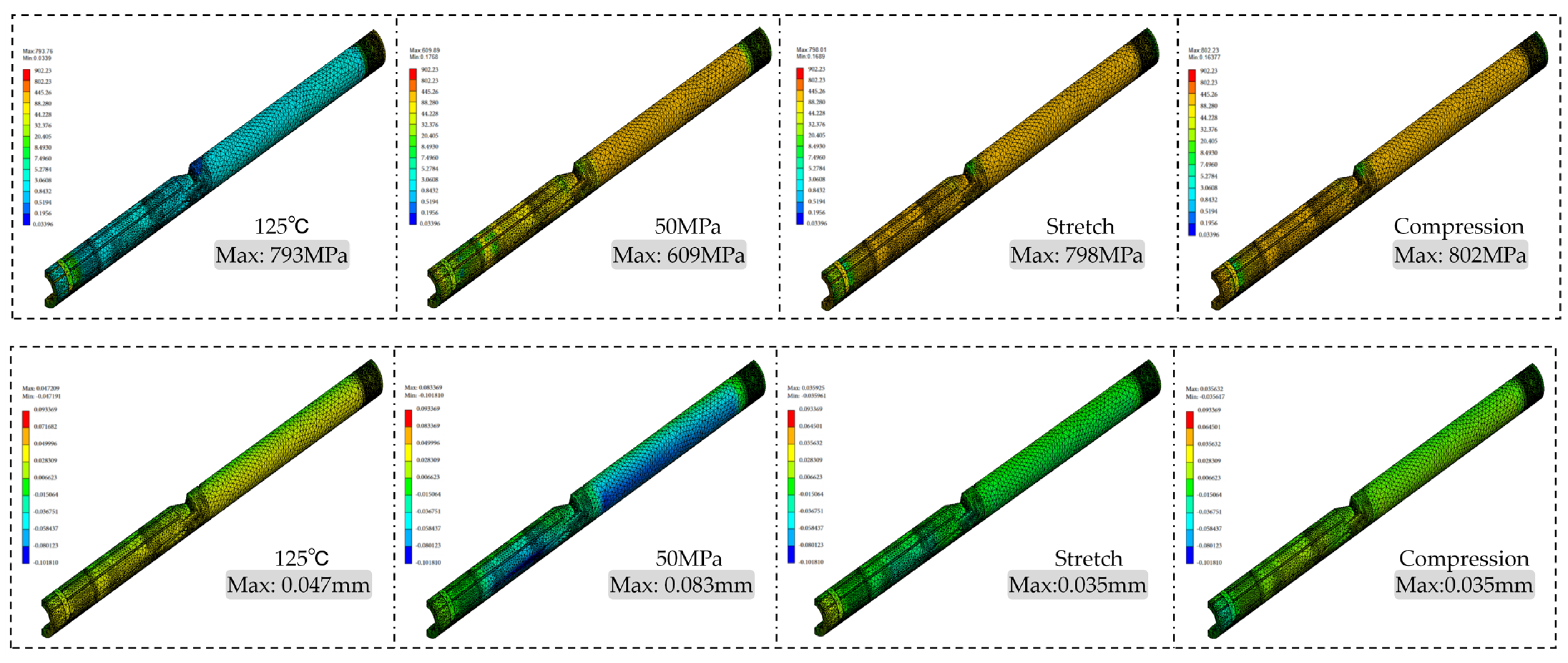



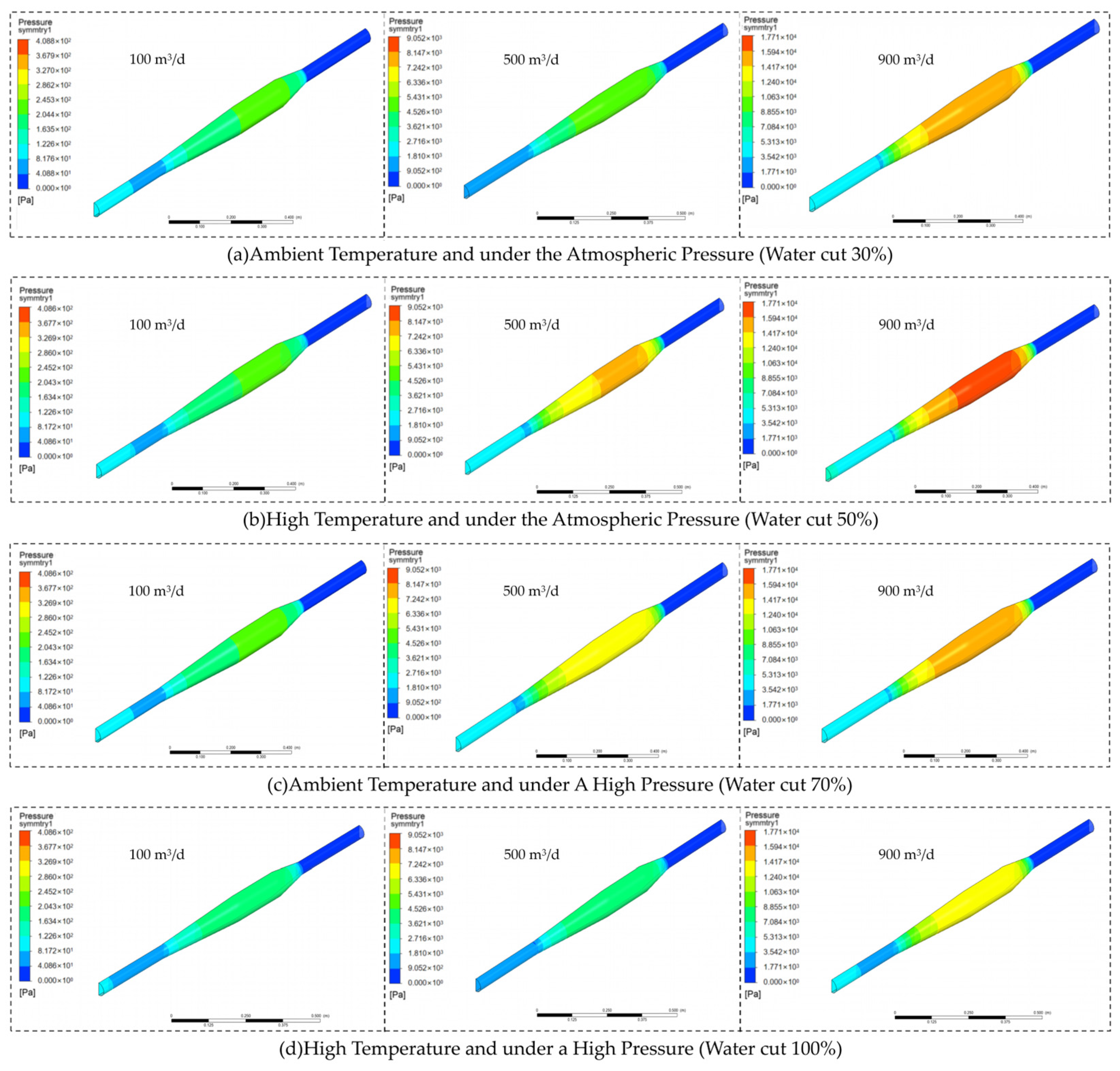
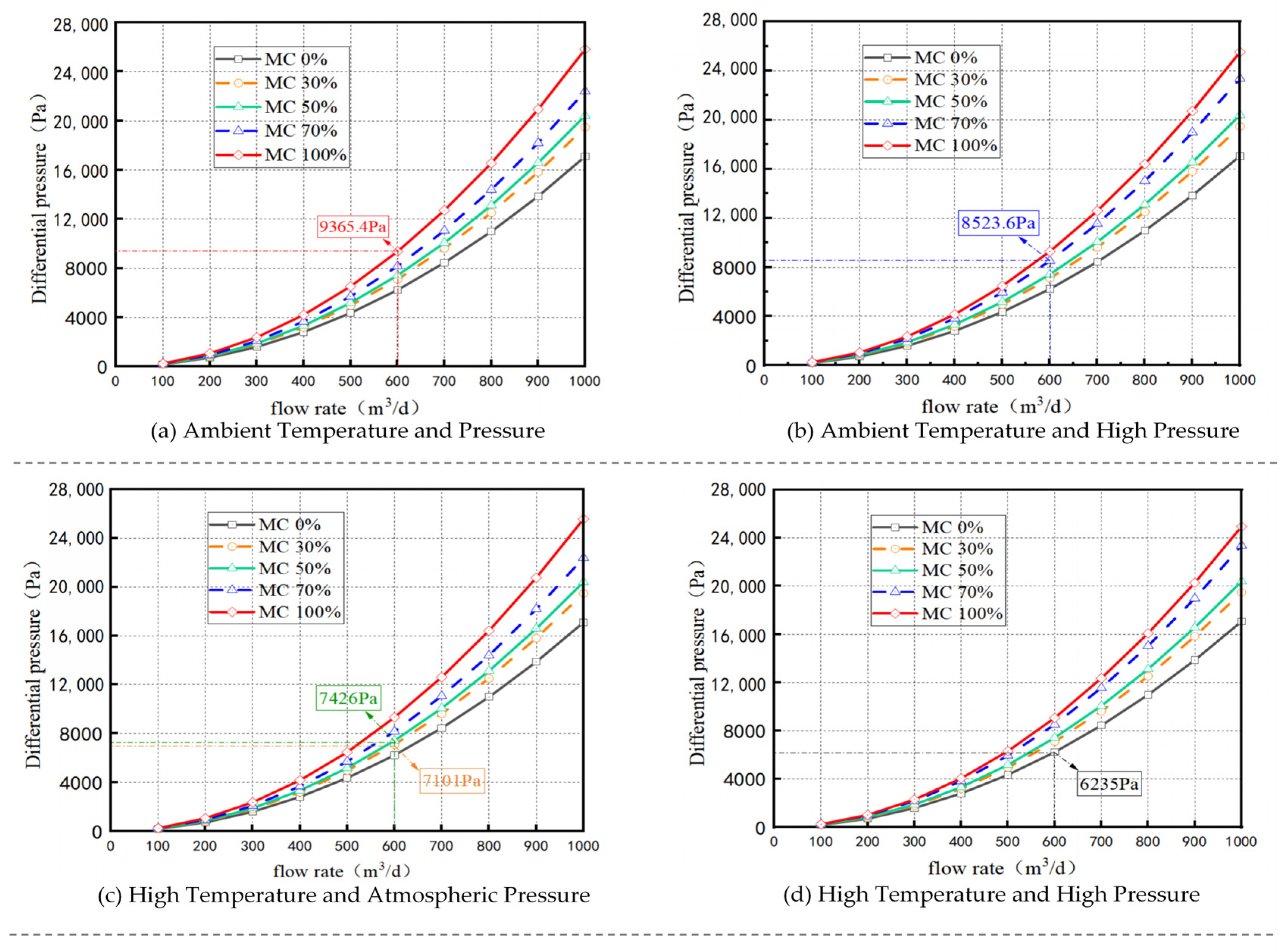

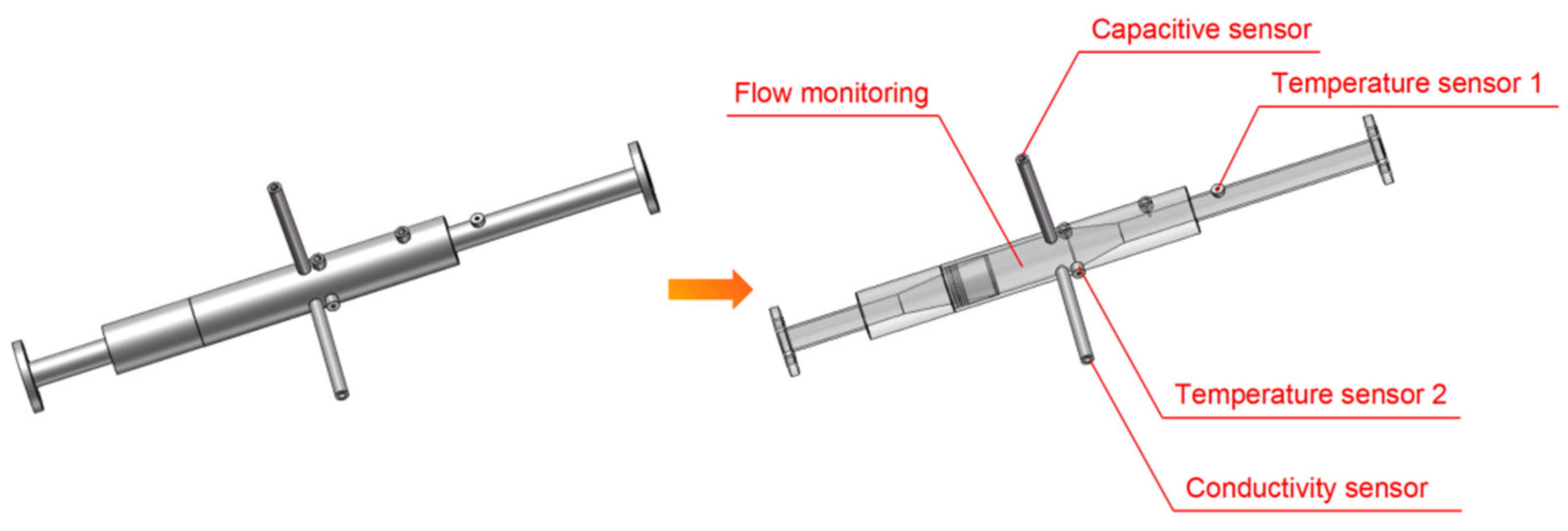


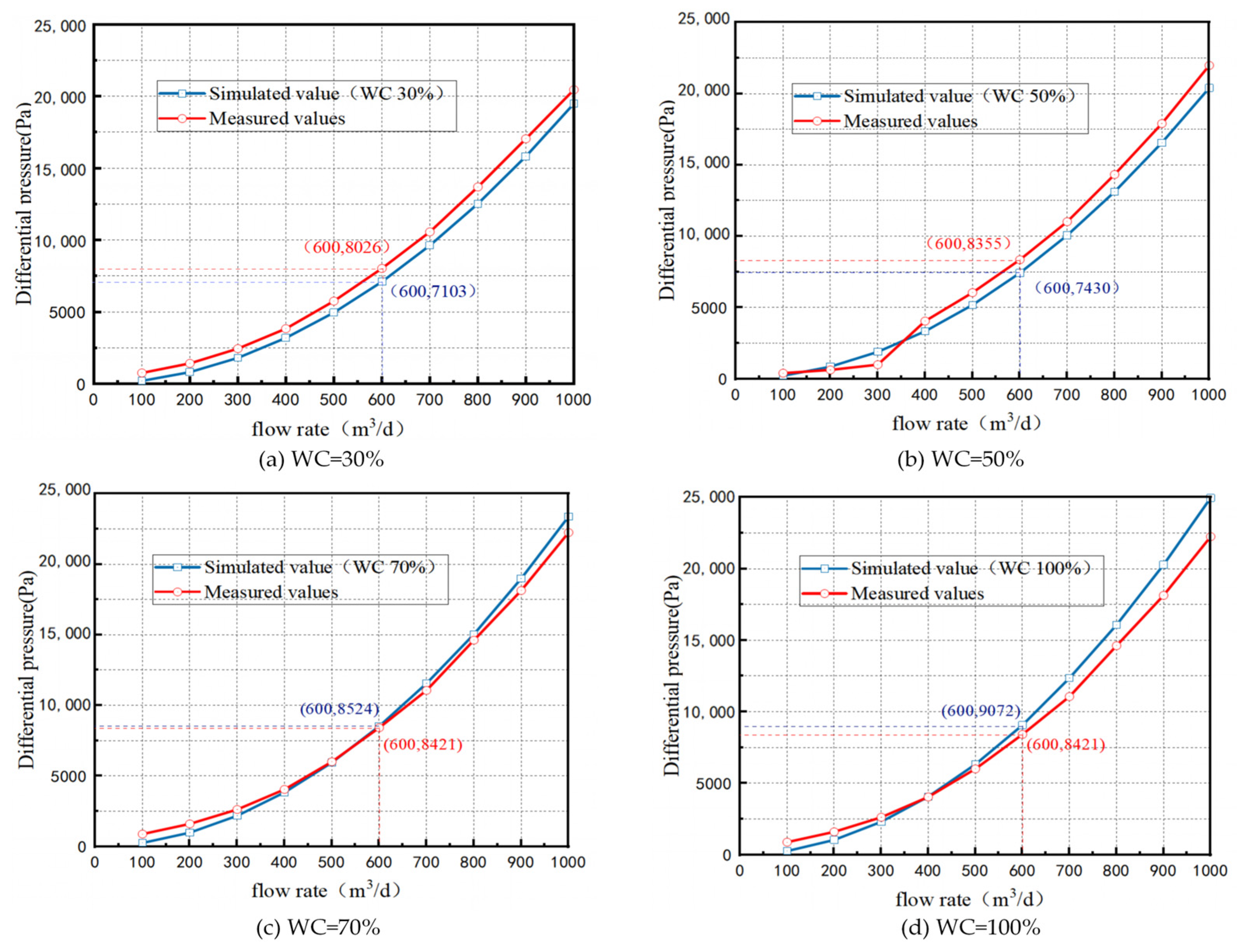
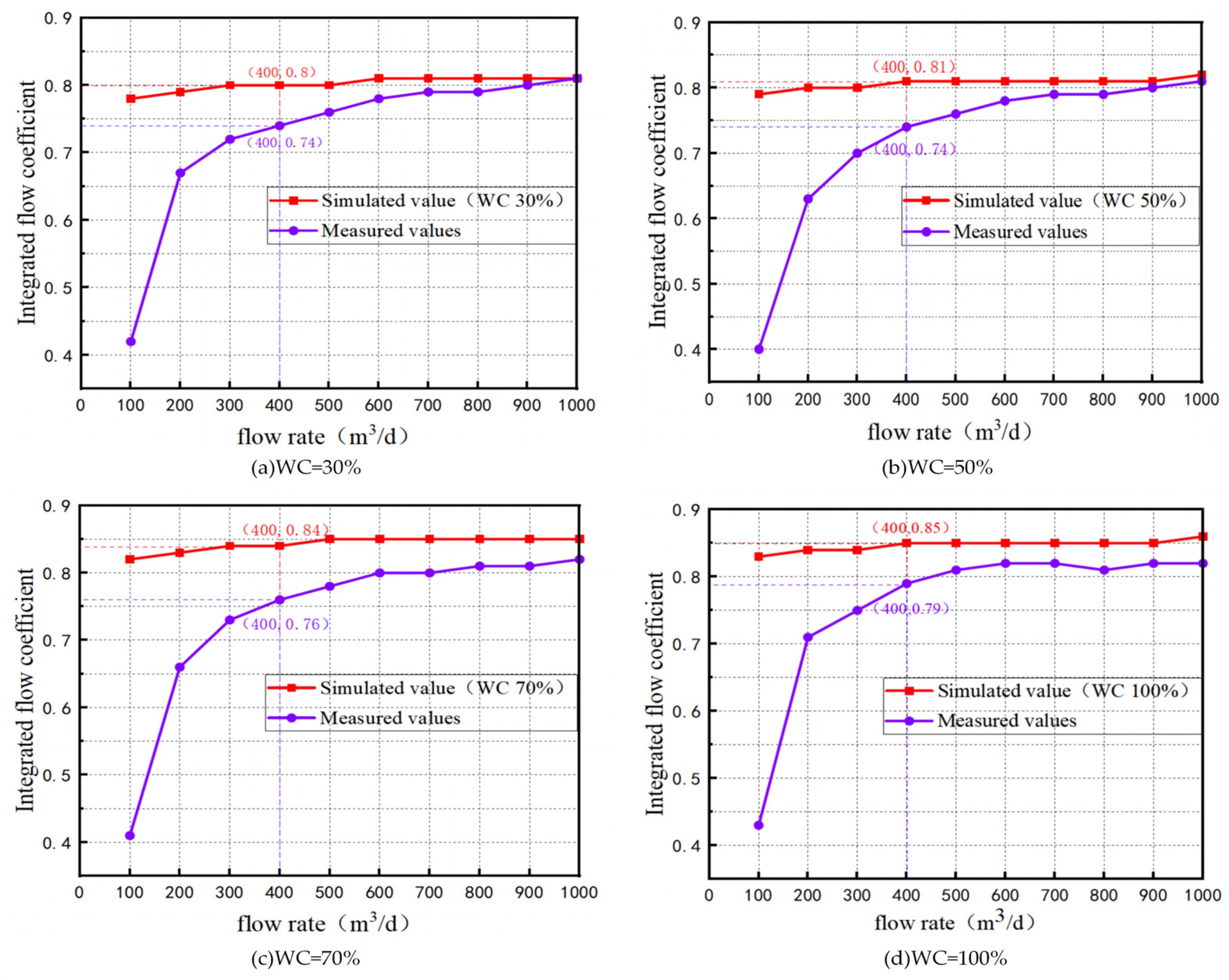
| Oil Tube | 3–1/2 | 4–1/2 | 5–1/2 | 7 |
|---|---|---|---|---|
| Liquid flow rate (With a high precision) m3/d | 1590–7950 | 1908–9540 | 3180–11,130 | 7950–15,105 |
| Liquid flow rate (With a medium precision) m3/d | 318–1590 | 795–1908 | 2385–3180 | 3975–7950 |
| Gas flow rate (With a high precision) m3/d | 113–368 | 226–679 | 269–933 | 340–1981 |
| Gas flow rate (With a medium precision) m3/d | 28.3–495 | 56.6–690 | 85–933 | 170–340 |
| Maximum outer diameter: mm | 154 | 191 | 210 | 280 |
| Inner diameter: mm | 73 | 94 | 112 | 155 |
| Flow measurement precision | ±2%–±5% | |||
| Type | Nominal Diameter DN(mm) | Comhoubi (β = d/D) | Angle of Contraction Segment | Extended Segment Angle | Materials |
|---|---|---|---|---|---|
| Precision cast shrinkage segment Venturi tube | 100–800 | 0.3–0.75 | 21 ± 1° | 7–15° | Cast iron |
| Machined shrink-segment Venturi tubes | 50–350 | 0.4–0.75 | Carbon steel, stainless steel | ||
| Rough welded iron plate shrinkage segment Venturi tube | 200–2800 | 0.4–0.7 | Carbon steel, stainless steel |
| Names | Materials | Boundary Condition Simulation and Analysis | |
|---|---|---|---|
| Real-time multi-parameter monitoring system for production | Top Connector | 42CrMo | 50 MPa, 125 °C, Stretch or compress 650 kN |
| Protective shell | |||
| Monitoring bin | |||
| Holistic multi-parameter real-time monitoring system for production | / | ||
| Sensors | Setpoint | Measured Value |
|---|---|---|
| Temperature sensor | 125 °C | 124.8 °C |
| 125.1 °C | ||
| 125.4 °C | ||
| Pressure sensors | 50 MPa | 51.98 MPa |
| 51.32 MPa | ||
| 49.95 MPa | ||
| Capacitive sensors (70 °C) | WC 0% | 0% |
| WC 30% | 32% | |
| WC 50% | 51% | |
| WC 70% | 67% | |
| WC 100% | 98% |
| Number | Number of Grids | Pressure Difference/Pa |
|---|---|---|
| 1 | 7622 | 5152.900 |
| 2 | 12,648 | 5172.580 |
| 3 | 25,191 | 5157.520 |
| 4 | 51,336 | 5142.140 |
| 5 | 181,040 | 5142.060 |
| 6 | 438,606 | 5141.990 |
| Water Cuts | 100 m3/d–1000 m3/d | |||
|---|---|---|---|---|
| 0% | 1 | 2 | 3 | 4 |
| 30% | 1 | 2 | 3 | 4 |
| 50% | 1 | 2 | 3 | 4 |
| 70% | 1 | 2 | 3 | 4 |
| 100% | 1 | 2 | 3 | 4 |
Disclaimer/Publisher’s Note: The statements, opinions and data contained in all publications are solely those of the individual author(s) and contributor(s) and not of MDPI and/or the editor(s). MDPI and/or the editor(s) disclaim responsibility for any injury to people or property resulting from any ideas, methods, instructions or products referred to in the content. |
© 2024 by the authors. Licensee MDPI, Basel, Switzerland. This article is an open access article distributed under the terms and conditions of the Creative Commons Attribution (CC BY) license (https://creativecommons.org/licenses/by/4.0/).
Share and Cite
Bi, G.; Fu, S.; Wang, J.; Wu, J.; Yuan, P.; Peng, X.; Wang, M.; Gong, Y. Research on Structural Design and Optimisation Analysis of a Downhole Multi-Parameter Real-Time Monitoring System for Intelligent Well Completion. Processes 2024, 12, 1597. https://doi.org/10.3390/pr12081597
Bi G, Fu S, Wang J, Wu J, Yuan P, Peng X, Wang M, Gong Y. Research on Structural Design and Optimisation Analysis of a Downhole Multi-Parameter Real-Time Monitoring System for Intelligent Well Completion. Processes. 2024; 12(8):1597. https://doi.org/10.3390/pr12081597
Chicago/Turabian StyleBi, Gang, Shuaishuai Fu, Jinlong Wang, Jiemin Wu, Peijie Yuan, Xianbo Peng, Min Wang, and Yongfeng Gong. 2024. "Research on Structural Design and Optimisation Analysis of a Downhole Multi-Parameter Real-Time Monitoring System for Intelligent Well Completion" Processes 12, no. 8: 1597. https://doi.org/10.3390/pr12081597





